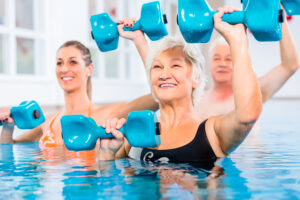Swimming isn’t just for kids or college athletes. It can be for seniors, too. Even for an aging person who depends on some type of elder care, swimming can be an aerobic activity that not only benefits their overall health and elevates the heart rate, but also works their muscles in a low impact environment.
There are many benefits that swimming or water aerobics offers aging men and women. Below are just a few to consider.
It is gentler on the joints.

Assisted Living Pascagoula, AL: Seniors and Swimming
Often, as people get older their joints become worn out, brittle, and painful. Simply walking up and down the stairs, down the hall, or doing other basic activities can take a serious toll on the knees, ankles, and even hips. For somebody who has arthritis, it’s even worse.
Swimming or even simply treading water can help to reduce joint pain and stiffness. That’s not the only benefit, though, because while an aging person who requires elder care can feel their joints loosening up, they can also strengthen their muscles.
When a person has healthier joints, it reduces the amount of pain he or she might experience on an average day. This will lead to higher impressions of quality of life, a happier outlook, and a more enthusiastic approach to other activities.
It can help to reduce age-related pain.
Even though swimming can be tough for some people, it is a low impact activity that can actually reduce the risk of injuries sustained through other activities. Just consider how walking or jogging and swimming compare.
When a person walks or jogs, their body weight is compressing down on their joints, most commonly their knees, hips, and ankles.
It’s an incredible amount of pressure being placed on those small parts of the body. The larger a person is, the more pressure is being placed on those joints. However, with swimming, there is no real pressure being placed on those joints.
The person will be moving their legs and arms to stay afloat or swim through the water, and that helps limit musculoskeletal pain in many seniors who take on swimming as a regular activity.
It may help to reduce the risk of osteoporosis.
This chronic bone and joint condition has the potential to turn a simple mishap, like stumbling over in your room, to a trip to the hospital. It is estimated that nearly 27 percent of women in their 70s and up to 35 percent of women in their 80s are dealing with osteoporosis.
In fact, it’s estimated that almost half of adults over the age of 50 are experiencing low bone mass, which is an indicator of potential osteoporosis in the future.
Swimming can help strengthen the bone structures in the body and even improve bone mineral density in the spine.
All in all, if an aging senior requires any elder care assistance, whether they’re living at assisted living or not (just yet), swimming is a wonderful physical activity that promotes healthy living and may actually be a factor in improving quality of life.


Follow Us!